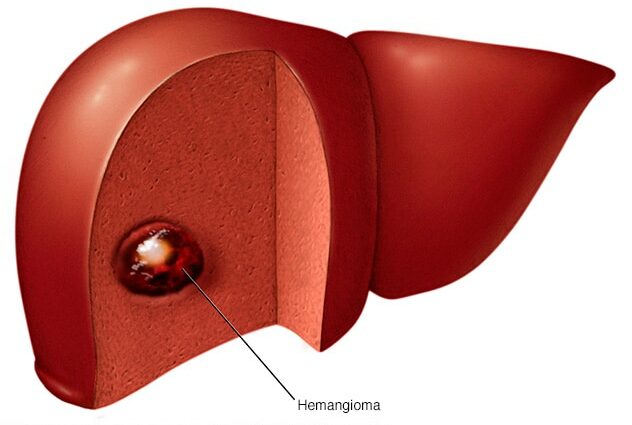Contents
Angioma of the liver
A common and minor pathology, angioma of the liver is a benign tumor that affects the hepatic blood vessels. In the vast majority of cases, it does not cause any symptoms and it is not necessary to operate.
What is an angioma of the liver?
Definition
Angioma of the liver, also called hemangioma or hepatic angioma, is a benign tumor that grows at the expense of blood vessels and forms a small mass made up of abnormal vessels.
Typically, angioma presents as an isolated, well-defined round lesion with a diameter of less than 3 cm (less than 1 cm every other time). The angioma is stable and does not cause any symptoms. Multiple angiomas can be spread throughout the liver.
The lesion can also take an atypical form. There are giant angiomas measuring up to 10 cm, others take the form of small entirely fibrous nodules (sclerotic angiomas), still others are calcified or connected to the liver by a pedicle …
Some angiomas can change in size over the long term, but do not degenerate into malignant tumors.
Causes
It is a lesion with no identified cause, probably of congenital origin. Some liver angiomas could be under the influence of hormones.
Diagnostic
Angioma is often discovered incidentally during an abdominal ultrasound. When the liver is healthy and the tumor measures less than 3 cm, the spotted nodule is clearly identifiable and there is no need for further examination.
When the angioma is atypical or in patients with underlying liver disease, such as cirrhosis or liver cancer, it may be mistaken for other types of tumors on ultrasound. The diagnosis is particularly very difficult for small angiomas in patients with malignant tumors.
Other imaging exams with injection of contrast products (ultrasound, CT scan or MRI) must then be performed to confirm the diagnosis. The MRI is the most sensitive and the most specific examination, and makes it possible to remove the doubt more than nine times out of ten.
If the diagnosis could not be made by imaging tests, a biopsy may be considered. The doctor will perform a puncture by inserting a needle through the skin. The diagnostic accuracy reaches 96%.
The people concerned
In the absence of symptoms and given the role of chance in the diagnosis, it is difficult to know exactly how many people have angiomas of the liver. EASL (European association for the study of the liver : European Association for the Study of the Liver) estimates that around 0,4% to 20% of the population would be affected (around 5% when the estimate is made on series of imaging examinations, but up to 20% in studies involving autopsied livers).
Liver angiomas are found in people of all ages, including infants, but they are more commonly seen in people aged 30 to 50 years, with a predominance of women.
Risk factors
Hormonal treatments may play a role in increasing the size of some liver angiomas. However, studies show that this risk is minor and a priori harmless. Oral contraception, in particular, is not contraindicated in women with non-progressive tumors and can be continued without special supervision.
Symptoms of an angioma of the liver
Most of the time, the angioma is and will remain asymptomatic.
Large angiomas, however, can compress adjacent tissue and cause inflammation and pain.
Complications
In rare cases, other complications can occur:
- thrombosis (formation of a clot),
- Kasabach-Merritt syndrome (SKM) characterized by an inflammatory reaction and a coagulation disorder,
- intra-tumor hemorrhage, or even effusion of blood in the peritoneum by rupture of the angioma (hemoperitoneum) …
Treatments for angioma of the liver
Small, stable, symptom-free angiomas do not need to be treated – or even monitored.
In other cases, arterial embolization (obstruction) may be proposed. Management may also be based on medical treatment with corticosteroids or other drugs. More rarely, surgery will be considered to remove the tumor.










